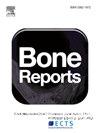Integrating deep learning and machine learning for improved CKD-related cortical bone assessment in HRpQCT images: A pilot study
IF 2.6
Q3 ENDOCRINOLOGY & METABOLISM
引用次数: 0
Abstract
High resolution peripheral quantitative computed tomography (HRpQCT) offers detailed bone geometry and microarchitecture assessment, including cortical porosity, but assessing chronic kidney disease (CKD) bone images remains challenging. This proof-of-concept study merges deep learning and machine learning to 1) improve automatic segmentation, particularly in cases with severe cortical porosity and trabeculated endosteal surfaces, and 2) maximize image information using machine learning feature extraction to classify CKD-related skeletal abnormalities, surpassing conventional DXA and CT measures.
We included 30 individuals (20 non-CKD, 10 stage 3 to 5D CKD) who underwent HRpQCT of the distal and diaphyseal radius and tibia and contributed data to develop and validate four different AI models for each anatomical site. Manually annotated cortical bone was used to train each segmentation deep-learning model. Textural features were extracted via Gray-Level Co-occurrence Matrix (GLCM) and classified as CKD or non-CKD using XGBoost with each segmentation model. For comparison, manufacturer-supplied segmentation was used to extract cortical geometry, microarchitecture, and finite element analysis (FEA) outcomes. Model performance was confirmed using the test dataset and a separate independent validation cohort which included HRpQCT imaging from 42 additional individuals (18 non-CKD, 24 CKD stage 5D).
For segmentation, the diaphyseal location showed strong performance on test datasets, with Mean IoUs of 0.96 and 0.95, and accuracies of 0.97 for both radius and tibia sites in CKD. Model 4 developed from the diaphyseal tibia region excelled in classifying test and independent validation datasets, achieving F1 scores of 0.99 and 0.96, AUCs of 0.99 and 0.94, sensitivities of 0.99, and specificities of 0.99 and 0.92. No single parameter, including BMD and cortical porosity, among conventional CT outcomes consistently differentiated CKD from non-CKD across all anatomical sites.
Integrating HRpQCT with deep and machine learning, this innovative approach enables precise automatic segmentation of severely deteriorated endocortical surfaces and enhances sensitivity to CKD-related cortical bone changes compared to standard DXA and HRpQCT outcomes.
整合深度学习和机器学习以改善HRpQCT图像中ckd相关皮质骨评估:一项试点研究。
高分辨率外周定量计算机断层扫描(HRpQCT)提供了详细的骨骼几何和微结构评估,包括皮质孔隙度,但评估慢性肾脏疾病(CKD)骨骼图像仍然具有挑战性。这项概念验证研究融合了深度学习和机器学习,以1)改善自动分割,特别是在皮质孔隙度严重和骨膜表面小梁的情况下;2)利用机器学习特征提取最大化图像信息,对ckd相关的骨骼异常进行分类,超越传统的DXA和CT测量。我们纳入了30名患者(20名非CKD, 10名3至5D CKD),他们接受了远端和骨干桡骨和胫骨的HRpQCT检查,并提供了数据,用于开发和验证每个解剖部位的四种不同的AI模型。使用人工标注的皮质骨来训练每个分割深度学习模型。通过灰度共生矩阵(GLCM)提取纹理特征,并使用XGBoost对每个分割模型进行CKD和非CKD分类。为了比较,使用制造商提供的分割来提取皮质几何形状、微结构和有限元分析(FEA)结果。使用测试数据集和一个单独的独立验证队列来确认模型的性能,该队列包括来自42个额外个体(18个非CKD, 24个CKD阶段5D)的HRpQCT成像。对于分割,骨干定位在测试数据集上表现出很强的性能,CKD的桡骨和胫骨部位的平均IoUs分别为0.96和0.95,准确率为0.97。从胫骨骨干区开发的模型4在分类测试和独立验证数据集上表现优异,F1得分分别为0.99和0.96,auc分别为0.99和0.94,灵敏度为0.99,特异性为0.99和0.92。在常规CT结果中,没有单一参数(包括骨密度和皮质孔隙度)能在所有解剖部位一致地区分CKD和非CKD。与标准的DXA和HRpQCT结果相比,这种创新的方法将HRpQCT与深度学习和机器学习相结合,可以精确地自动分割严重恶化的皮质内表面,提高对ckd相关皮质骨变化的敏感性。
本文章由计算机程序翻译,如有差异,请以英文原文为准。
求助全文
约1分钟内获得全文
求助全文
来源期刊

Bone Reports
Medicine-Orthopedics and Sports Medicine
CiteScore
4.30
自引率
4.00%
发文量
444
审稿时长
57 days
期刊介绍:
Bone Reports is an interdisciplinary forum for the rapid publication of Original Research Articles and Case Reports across basic, translational and clinical aspects of bone and mineral metabolism. The journal publishes papers that are scientifically sound, with the peer review process focused principally on verifying sound methodologies, and correct data analysis and interpretation. We welcome studies either replicating or failing to replicate a previous study, and null findings. We fulfil a critical and current need to enhance research by publishing reproducibility studies and null findings.
 求助内容:
求助内容: 应助结果提醒方式:
应助结果提醒方式:


